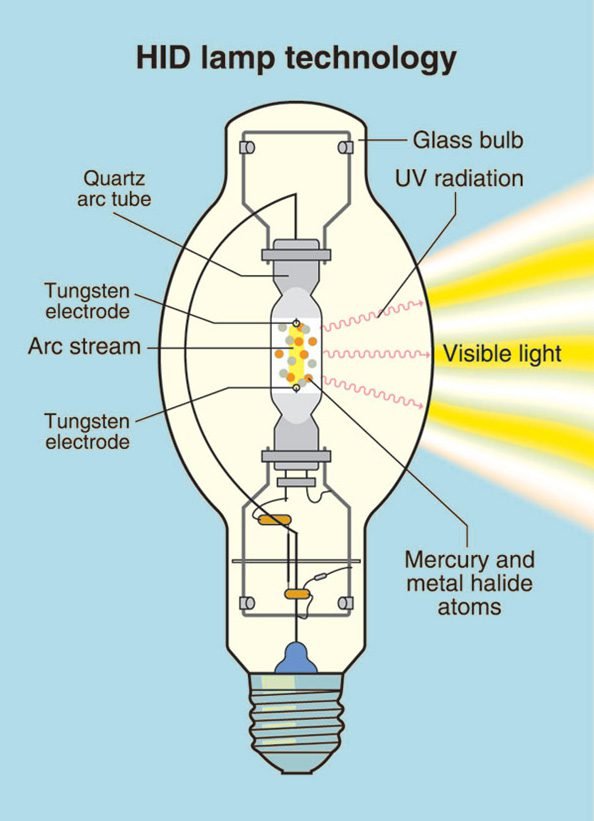In the third part of operation and parameters of lamps, the subject is about high intensity discharge or HID and neon.
HID
The type of high discharge lamp (HID) creates a high electric discharge between tungsten electrodes. The gas inside lamp gets ionized and becomes a conductor. An electric current is produced, electrons colide with atoms of ionized gas, atom’s electrons gain energy and goes to another orbit with higher energy. When return to a more stable orbit, emit light.

The arc tube, where is the gas and electrodes, is made of quartz or aluminum oxide (), for being good electrical insulants and high resistance to heat. The external bulb serves to protect inner parts and block ultraviolet radiation (UV), the latter is converted in visible light when there are a phosphorus layer in inner wall of external bulb. Some types of lamp does not have phosphorus coating.

To produce these high voltage discharges, lamps need a circuit called reactor. Operation of this device will be subject to other article.

Neon

Has a low pressure neon gas. A neon lamp needs an alternate electric voltage around 15.000 V to work. In this voltage, neon atoms (3) lose electrons, free electrons (5) go to positive terminal and ionized atoms (4) are attracted by negative terminal.

Can work with DC voltage, but only negative electrode (cathode) will be on. Exist small neon lamps which work with lower voltages.

Neon gas (Ne) produces red color, argon (Ar) generates blue color, other noble gases produce the colors shown below. To create other colors, must combine gases or put phosphorus in inner side of tube.

Lifespan varies between 10,000 and 25,000 hours, depends on the color. Luminous efficiency also depends on color, red light has 50 lumens/watt, while green has 65 lumens/watt. Lamp’s CRI for white light is 70. Neon lamp is between 5 and 10% less efficient than LED in energetic issue.
Types of HID lamps
High pressure mercury vapor

It is the oldest of HID lamps. In this type, argon gas and solid mercury stay inside the internal tube and nitrogen gas is filled outside quartz tube. When is on, mercury is evaporated and emits UV, for this reason, external bulb is made of borosilicate to reduce this radiation. Has a starter electrode connected to a resistor which generates arc with main electrode to heat the tube to evaporate mercury, stays close to one of main electrodes. With that, reduces necessary voltage.

The luminous efficiency is between 30 and 60 lumens/watt. Lifespan is around 24,000 hours, some last 157,000 hours. CRI is 20, but with phosphorus coating, can reach 60.
This lamp takes a time to heat before is on in maximum intensity. After shut down, must wait some minutes to turn on again. Also loses luminosity with time.
High pressure sodium (HPS)

Used in street lighting, arc tube is made of ceramic oxide aluminum. Inside internal tube there are xenon gas, mercury and sodium. On lighting up, first xenon is ionized, then the mercury is vaporized followed by sodium vaporization. Sodium produces yellow color, combining with mercury, it is generated an orange tone. External bulb filters UV and protects internal parts from oxidation.

Sodium is very reactive, can’t be exposed to air due to humidity or can burn. These lamps need a device called getter, has the function to keep vacuum stability inside external bulb, sucking oxygen and undesirable gases.

The Reproduction color index is too low, between 20 and 30, therefore it is used in applications where color reproduction isn’t important. Lifespan is about 24,000 hours. Luminous efficiency is between 80 and 150 lumens/watt.
Also needs time to warm up and after turns off, some lamps with 2 tubes can be turned on instantly. Exist deluxe HPS lamps, have RCI between 60 and 80. However, are more expensive, less efficient and a lower lifespan.

Metal halide

Emit a very white and pure light, are used in stadiums, warehouses, parking lots and where light quality is important. However are expensive and cause luminous pollution.

Inside quartz internal tube there are argon gas, mercury and halide salts. Metal halide is a salt from a metal (usually silver) with a halogen. First, argon is ionized, then mercury is vaporized and after that salt’s vaporization. Also needs time to warm up and turns on again. This lamp also has auxiliar electrode to start.

Luminous efficiency is between 65 and 115 lumens per watt, depends on lamp’s size. Are 3 or 5 more efficient than incandescent lamps. Can last from 6,000 to 20,000 hours. CRI is between 60 and 90, depends on salt’s composition.



